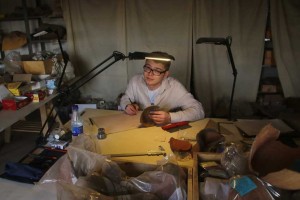The final phase of our 2015 field season is approaching, only three more weeks to go!
This week, Miranda Semple and Sayantani Neogi successfully completed their geoarchaeological research respectively the micromorphological sampling within the New Kingdom town area – several profiles of cultural deposition were taken from SAV1 West and SAV1 East. This set of soil blocks is the starting point for thin section manufacture and micromorphological analysis in the upcoming years. Taken from 18th Dynasty contexts, they will allow us addressing questions of site formation processes and the ancient use of space.
Our group of Viennese physical anthropologists (Anna Sonnberger, Andrea Stadlmayr and Marlies Wohlschlager) started their work with sorting bones from the town excavation – even if there are some interesting human remains from SAV1 West and SAV1 East, they are of course eagerly waiting for new material from the cemetery site SAC 5. At the cemetery, the group of workmen supervised by Pierre Meyrat and Huda Magzoub were busy with surface cleaning in area 1. No clear outlines of possible superstructures or shafts of New Kingdom tombs were yet found, but several sandy areas are notable.
In the magazine, registering of both finds and pottery continued. In addition, Sabine Tschorn has joint us to work on the quite substantial corpus of Nun-bowls from the town site. The current focus of find processing, however, is still on the large amount of material coming from feature 15 – Oliver Frank Stephan is currently drawing the intact and almost complete vessels from this important context. A large number of pots is broken in many fragments – reconstructing and gluing them is very time-consuming, but of course essential.
Ken Griffin and Meg Gundlach continued with registering finds – our database now comprises a total of 3800 objects! Especially interesting is the corpus of seal impressions from feature 15 – 42 mud sealings were already registered, more than a dozen new ones just came up today! There is a number of well-preserved impressions of seals of Hatshepsut and Thutmose III, but others are still in the style of the Second Intermediate Period.

One of the fragmented mud sealings with a knotted geometrical pattern common in the Second Intermediate Period.
Processing and photographing different categories of finds, drawing and sorting of ceramics and of course the field work in the cemetery SAC 5 will keep us very busy in the next weeks.


